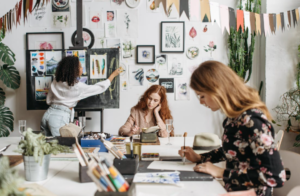
Art education has the power to shape creative thinkers and problem solvers, but keeping up with the ever-changing world of art can be challenging for teachers. According to recent studies, educators who invest in continuing education see significant improvements in their teaching effectiveness and student engagement. Yet, many art teachers find themselves stuck with outdated methods, struggling to inspire students in a world driven by innovation and technology.
By investing in their education, art teachers can overcome these obstacles, stay relevant in their field, and unlock new possibilities for themselves and their students. Let’s explore why art teachers should prioritize their own learning and how it can transform their teaching journey.
Learn Innovative Teaching Techniques
Every classroom is unique, with students who learn in different ways. Traditional teaching methods may not always engage today’s tech-savvy generation. Continuing education allows art teachers to explore modern, effective teaching strategies tailored to diverse learning needs.
For example, some programs focus on project-based learning, where students work on real-world problems through art. Others emphasize collaborative approaches that encourage peer interaction and creativity. These techniques not only enhance student engagement but also make the learning process more enjoyable for teachers.
Build Confidence in Your Teaching Approach
Investing in education allows art teachers to feel more confident in their abilities. Confidence comes from having a thorough understanding of the subject matter and knowing how to teach it effectively. Programs like a Master of Arts in Teaching (MAT) are specifically designed to deepen teachers’ pedagogical skills while providing advanced knowledge in their field.
For art teachers, an MAT can help refine lesson planning, classroom management, and evaluation techniques. It equips educators with research-based strategies that make teaching both effective and enjoyable. By pursuing such a degree, teachers gain the tools to navigate challenges, whether it’s guiding a student through a complex project or addressing classroom dynamics, ultimately fostering a more productive learning environment.
Harness the Power of Technology in Art
Technology has revolutionized the art world, and integrating it into the classroom is no longer optional. Digital tools like graphic design software, virtual reality platforms, and 3D printers have expanded the possibilities for artistic expression. However, many teachers feel unequipped to use these tools effectively.
Investing in professional development programs that focus on technology can bridge this gap. Teachers can learn to use software such as Adobe Photoshop or Procreate, enabling them to teach students valuable skills for the modern workforce. Additionally, incorporating technology into lessons can make classes more engaging and relevant to today’s digital natives.
Inspire Students Through Advanced Knowledge
When teachers invest in their own growth, it directly impacts their students. Gaining advanced knowledge in specific art forms or teaching methods equips educators to offer deeper insights and richer lessons. Students notice when their teachers are passionate and knowledgeable, and this enthusiasm is contagious.
For instance, a teacher who has recently studied abstract art can introduce students to new techniques and ideas, encouraging them to experiment beyond traditional forms. This ripple effect not only enhances the quality of education but also boosts students’ confidence in their creative abilities.
Broaden Career Opportunities in the Field
Continuing education doesn’t just improve teaching—it also opens doors to new career paths. Art teachers who expand their qualifications may qualify for leadership roles, curriculum design positions, or teaching at higher education levels.
Specialized certifications, such as those in digital media or art therapy, can make educators more versatile and in demand. Moreover, professional growth often leads to higher job satisfaction, as teachers feel more empowered and valued in their roles. By investing in themselves, art educators can shape not just their careers but also the future of art education.
Create Connections with Fellow Educators
One of the overlooked benefits of continuing education is the opportunity to network with other art teachers. Engaging in professional workshops, conferences, or online courses allows teachers to meet peers who share their passion for art education.
These connections are valuable for exchanging ideas, discussing challenges, and finding inspiration. For instance, a teacher might learn about a successful project another educator implemented and adapt it to their own classroom. Networking also opens doors to potential collaborations, such as co-teaching initiatives or community art projects that benefit students and the broader community.
Adapt to the Needs of Diverse Students
Art classrooms are diverse spaces, often filled with students from various cultural and socioeconomic backgrounds. Some students may have learning disabilities or other challenges that require personalized attention. Investing in education helps teachers develop strategies to meet the unique needs of every student.
Courses on inclusive teaching or cultural competence equip educators to create a welcoming environment for all learners. Teachers can learn how to modify assignments, use alternative teaching methods, and ensure that every student has an equal opportunity to succeed. This approach fosters a sense of belonging and encourages students to explore their creative potential without fear of judgment.
Investing in education is one of the most impactful steps an art teacher can take for their career and their students. It helps teachers stay relevant, master new skills, and build confidence in their teaching. It also enriches the classroom experience by introducing innovative techniques, tools, and approaches that benefit students of all backgrounds.
Professional development isn’t just about improving teaching methods; it’s about embracing the evolving world of art and education. By prioritizing their own growth, art teachers not only enhance their careers but also set a powerful example for their students. For any art educator, the question isn’t whether to invest in education—it’s when to start.
